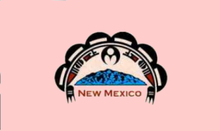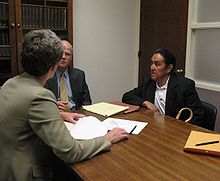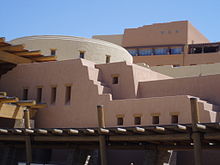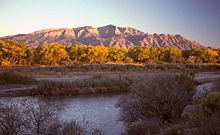- Sandia Pueblo
-
Sandia Pueblo 
Total population 500 - 600 Regions with significant populations  USA (New Mexico)
USA (New Mexico)500 Languages English, Tiwa
Religion Catholicism, traditional Pueblo religion
Related ethnic groups Other Pueblo peoples
Sandia Pueblo (
 /sænˈdiːə/) is a tribe of Native American Pueblo people inhabiting a 101.114 km² (39.04 sq mi) reservation of the same name in the eastern Rio Grande Valley of central New Mexico, located three miles south of Bernalillo off Highway 85 in southern Sandoval County and northern Bernalillo County, at 35°14′49″N 106°32′50″W / 35.24694°N 106.54722°W. It is bounded by the city of Albuquerque to the south and by the foothills of the Sandia Mountains, a landform the people hold sacred and which was central to the traditional economy and remains important in the spiritual life of the community, to the east. A forested area known as the bosque surrounds the rest of the reservation, and serves as a source of firewood and wild game. A resident population of 4,414 was reported as of the 2000 census. Two communities located on its territory are Pueblo of Sandia Village and part (population 3,235) of the town of Bernalillo.
/sænˈdiːə/) is a tribe of Native American Pueblo people inhabiting a 101.114 km² (39.04 sq mi) reservation of the same name in the eastern Rio Grande Valley of central New Mexico, located three miles south of Bernalillo off Highway 85 in southern Sandoval County and northern Bernalillo County, at 35°14′49″N 106°32′50″W / 35.24694°N 106.54722°W. It is bounded by the city of Albuquerque to the south and by the foothills of the Sandia Mountains, a landform the people hold sacred and which was central to the traditional economy and remains important in the spiritual life of the community, to the east. A forested area known as the bosque surrounds the rest of the reservation, and serves as a source of firewood and wild game. A resident population of 4,414 was reported as of the 2000 census. Two communities located on its territory are Pueblo of Sandia Village and part (population 3,235) of the town of Bernalillo.A federally-recognized tribe, Sandia Pueblo is one of 19 of New Mexico's Native American pueblos. It is known as one of the state's Eastern Pueblos. Its 500 people are traditionally Tiwa speakers, a language of the Tanoan group, although retention of the traditional language has waned with later generations. They have a tribal government that operates Sandia Casino, Bien Mur Indian Market Center, and Sandia Lakes Recreation Area, as well as representing the will of the Pueblo in business and political matters.
Contents
Name
The Tiwa name for the pueblo is Tuf Shur Tia, or "Green Reed Place", in reference to the green bosque (Spanish: forest). However, older documents claim that the original name of the pueblo was Nafiat, (Tiwa: "Place Where the Wind Blows Dust").
It became known as Sandía (Spanish: "watermelon") in the early 17th century, and possibilities abound as to why. Some claim that a type of squash cultivated there reminded the Spaniards of the melons they knew from the Eastern hemisphere. Others suggest that explorers found an herb called sandía de culebra, or possibly another called sandía de la pasión there.[1]
But the most convincing and most-cited explanation is that the Spanish called the mountain Sandía after viewing it illuminated by the setting sun. The Sandia Mountains have a red appearance to them, and the layer of vegetation gives it a luminous "rind" of green when backlit, giving it the appearance of a sliced watermelon. The village closest to the range took on the name of the mountain, changing from throughout the years from San Francisco de Sandía to Nuestra Señora de los Dolores de Sandía to Nuestra Señoría de los Dolores y San Antonio de Sandía before ending up as simply Sandia Pueblo or Pueblo of Sandia.
History
Antiquity
During a 1936 expedition, experienced archeologist Wesley Bliss excavated the Sandia Cave, a cave in the Sandia Mountains, and reported his findings to University of New Mexico project head Dr. Brand. Frank C. Hibben, a UNM student who had not been involved in the excavation, later worked in the cave. He reported finding a spearpoint beneath a layer of material dating more than 25,000 years old, along with the bones of camels, mastodons, and prehistoric horses.[2] The 25,000-year age suggested by Hibben was erroneous, as the bones were carbon dated from 14,000–20,000 years ago (16,000–14,000 BCE). The published notes of Bliss and others in reference to the poor layer integrity and cross-layer contamination associated with rodent burrowing proved that Hibben's dating of historical sedimentary layers was consistently inaccurate.[3] [4]
Frank Hibben's claim of a Clovis point dating to more than 25,000 years ago is cited as strong evidence for the existence of a much older pre-Folsom culture in North America (as contended by the authors of the controversial Forbidden Archaeology).[5] However, Hibben's publications misrepresented the initial excavation work of Wesley Bliss, who noted the proper layers, and the poor layer integrity in areas, among other findings that were erroneously misconstrued and reported by Frank Hibben to prop up his theory. Bliss did not find any of the spearpoints in the layers reported later by Hibben. It is now believed that the spearpoints were not as old as was originally reported by Hibben, and Hibben's sloppy work and false testament to man's history in North America has greatly hindered the accuracy of our understanding of prehistoric North America. Frank Hibben was generously rewarded for this falsified work, which assisted him greatly in starting his impressive career, supported by the University of New Mexico. The errors in Hibben's work were covered up for 60 years until being openly acknowledged and reported.[6]
It is from this dig that Sandia or Sandia-type points derive their name. They appear to be the remains of the Paleo-Indian Llano or Clovis Culture. Until about CE 400–500, cultural groups residing in the area practiced the Desert Culture of migratory hunter–gatherers. At that time, agriculture and sedentary life began to take hold, although the populations present are known to have relied on older economies in times of want. Cotton, beans, squash, and maize were cultivated, and the arts of basketry and textile weaving were developed.[7]
The Pueblo culture developed from 700–1100, characterized by its distinctive religious beliefs and practices and a large growth in population. The period from 1100–1300 CE is known as the Great Pueblo Period, and is marked by cooperation between the Pueblo peoples and the communal Great Kiva ritual. The Sandia Pueblo has resided in its current location since the 14th century, when they comprised over 20 pueblos. They were a thriving community, numbering 3,000 at the time of the arrival of Coronado in 1539 (in the Pueblo IV Era).[8]
Encounter with Westerners and life under New Spain
Spanish conquistador Francisco Vásquez de Coronado "discovered" the Pueblo of Sandia in 1539 while on an expedition to discover the Seven Cities of Cíbola.
In 1610, Fray Esteban de Perea, known as the "Apostle of Sandia", arrived. A descendent of a distinguished Spanish family, he was Guardian, Commissary, and Custodian of the friars in New Mexico, and was responsible for the implementation of the Inquisition in the territories under his authority. The tradition of witchcraft may have led to the Holy Office's establishment.
In 1617 the area became home to the seat of the Mission of San Francisco. The Spanish exacted tribute and enslaved members of the Sandia Pueblo people for labor in the building of churches and in Mexican mines. As a result of the resentment against this abuse, the Sandia, who had already offered sanctuary for Zia and Jemez rebels, were one of the pueblos involved in the August 10, 1680 Popé-led Pueblo Revolt against Spanish rule that drove the Spanish from the region until its reconquest by Diego de Vargas in 1692. They did not find freedom, however, as Popé and his successor Luis Tupatu exacted as heavy a tribute as the Spanish and the raiding tribes had. By way of punishment for their insurrection, then governor of the territory, Antonio de Otermin, ordered the village, which by that time had been abandoned, burned on August 26. Having fled to neighboring Hopi lands, the rectory at Sandia was left unprotected and was looted.[9]
The Sandia returned after each Spanish attack, with the 441 surviving Sandia resettling permanently in November 1742. In 1762, Governor Tomas Cachupin ordered the rebuilding of Sandia Pueblo (although his concern was primarily the housing of the Hopi who had found refuge there) as a buffer between the settlement at Albuquerque and the raids of the semi-nomadic Navajo and Apache. As a result, Sandia was raided continuously, the most deadly of such events occurring in 1775 when a Comanche raid killed thirty. The Hopi suffered the brunt of the attack as a result of their segregation from the Sandia, which has minimized their influence in the Pueblo. As a result of wars with Spanish conquistadors and raids from neighboring indigenous nations, the Sandia Pueblo diminished, numbering 350 by 1748, and dwindling to 74 by 1900.
Life in Mexico and the United States
 Sandia Pueblo Governor Victor Montoya (right) meeting with Congresswoman Heather Wilson.
Sandia Pueblo Governor Victor Montoya (right) meeting with Congresswoman Heather Wilson.
Rule of the territory passed to Mexican hands at the end of the Mexican War of Independence in 1820. It proved difficult to establish a new republic and govern outlying territories with a history of insubordination at the same time, and New Mexico enjoyed a brief semi-autonomous period resembling the salutary neglect of the American colonies. In American history, this period is often referred to as the "Wild West", in reference to relative absence of Mexican authority, which left the region open to incursion from and settlement by American pioneers.
With the end of the Mexican-American War in 1848, the territory of New Mexico was ceded to the United States. Zebulon Pike made note of the Sandia Mountains during his 19th century expedition, calling them the "San Dies".
When Indian schools were built in Albuquerque and Santa Fe, Sandia pupils were in attendance. Nonetheless, American culture did not have a strong effect on the tribe until World War II, when the tribe sacrificed eight of their young men to the national defense. The pueblo became electrified in 1952.
Tribal authorities have sometimes had conflicts with state and federal authorities. They have sought to assert their longstanding claim to the Sandia Mountains east of the ridge, and they strongly opposed the construction of the Sandia Peak Tramway in 1966.
The tribe opened a casino in 1994, and have since expanded and added a hotel to the facility. The casino's amphitheater hosts many acts passing through Albuquerque, and its proximity to the state's main urban center has made it a popular attraction among gamblers. The tribe has used the windfall to finance the education of their youth (i.e., every member who wants it is guaranteed a college education) and is currently financing a wastewater treatment plant. They also make contributions to several local charities. Some problems the Pueblo currently faces are alcoholism and teen pregnancy.
Government
The tribal government has educational, police, maintenance, health and human services, environmental, and economic development departments. "A Governor, Lt. Governor, Warchief, and Lt. Warchief are appointed for annual terms according to Sandia's cultural tradition. Each man can be appointed to consecutive terms. The Governor and Warchief will become Tribal Council members for life. The Warchief and Lt. Warchief are responsible for all religious activities held in the Pueblo. The Governor oversees day to day government operations, while the Lt. Governor is the Tribal Court Judge."[10]
Culture
Religion
The Sandia are a deeply religious people, and to this day remain very secretive about many aspects of their religion. Early reports discuss devotion to santos, or effigies of saints, a syncretic phenomenon common throughout the Southwest.
Though nominally Catholic, they preserve many of their pre-Catholic traditions. Their feast day, a tradition common to all Pueblo people, is celebrated yearly on June 13. This feast, or fiesta, as it is called, is open to the public. Music and dance are big parts of the ceremony, and it is considered an honor to participate.[11]
Other holy days are closed entirely, and non-Indian residents must leave (sometimes for days at a time) during these ceremonies. Personal feast days are celebrated too, with the tradition of "throwing", when gifts are thrown from rooftops to the recipients below.
The people have a deep connection to the Sandia Mountains, which they refer to as "the Mountain", and think of as their "church." They use the mountain as their official symbol.
Early documents discuss the belief in kachinas and the creation of kachina dolls, a practice that may continue. Males undergo secret initiation rituals involving the use of kivas, but little else is known about the rite in the outside world.
In a tradition similar to the saying of grace, Sandia people place a bit of their meal in a receptacle in remembrance and sacrifice.
Tales of belief in and fear of witchcraft date from the earliest accounts of the pueblo.
Language
Main article: Southern Tiwa languageToday, English is the common language of the Pueblo, although it is sprinkled with Southern Tiwa and Spanish words and expressions. Older generations speak Southern Tiwa, Spanish, and English, but younger generations have reportedly not preserved linguistic traditions as well as their elders.
Interestingly, many Spanish words incorporated into common usage, such as horno (Spanish for "oven") and bosque (Spanish for "woods"), are now pronounced with an "American" accent. (Horno, referring to the ceramic outdoor oven still in common use, is pronounced ['hor no] (cf. Spanish ['or no]), and bosque is pronounced ['bas ki] (cf. Spanish ['bos ke]).
At Sandia, Southern Tiwa is still used in music, ceremony, and daily life.
Arts
The Sandia people are known for their pottery, and sell hand-crafted arts through the Bien Mur Indian Market Center.
Dress and hairstyle
The Spanish reported that the Sandia people wore elegant garments adorned with turquoise. At that time, they wore their hair like the Isleta and San Ildefonso tribes. Now they dress and wear their hair like any other Americans, although there is a tendency for men to grow their hair long, as is common in the Native American community in general.
References
- ^ Stanley, Francis (1968). The Sandia New Mexico Story. Pep, Texas: P.O. Box 11. p. 3. LCCN F804.S19 C7.
- ^ Josephy, Jr., Alvin M. (1973). The Indian Heritage of America. New York: Bantam Books. p. 42.
- ^ Bliss (1940a). "A Chronological Problem Presented by Sandia Cave, New Mexico". American Antiquity (Society for American Archaeology) 5 (3): 200–201. doi:10.2307/275278. JSTOR 275278.
- ^ "Sandia Cave". Correspondence in American Antiquity 6 (1): 77–78. 1940b.
- ^ Lepper, Bradley T. (1996). "Hidden History, Hidden Agenda: A Review of The Hidden History of the Human Race, by Michael A. Cremo and Richard L. Thompson". TalkOrigins Archive. http://www.talkorigins.org/faqs/mom/lepper.html. Retrieved 2008-01-17.
- ^ "The Mystery of Sandia Cave". New Yorker Magazine (New York) 71 (16): 66–83.
- ^ Kantner, John (2004). Ancient Puebloan Southwest. Cambridge: Cambridge University Press. ISBN 0-521-78310-0.
- ^ "History of Sandia Pueblo". Sandia Pueblo website. Pueblo of Sandia. 2006. Archived from the original on 2008-01-02. http://web.archive.org/web/20080102031937/http://www.sandiapueblo.nsn.us/history.html. Retrieved 2008-01-17.
- ^ Hackett, Charles Wilson (1970). Revolt of the Pueblo Indians. Albuquerque: University of New Mexico Press.
- ^ "Government". Sandia Pueblo website. Sandia Pueblo. 2006. Archived from the original on 2007-10-12. http://web.archive.org/web/20071012192702/http://sandiapueblo.nsn.us/sandia_government.html. Retrieved 2008-01-17.
- ^ Sweet, Jill Drayson (2004). Dances of the Tewa Pueblo Indians: expressions of new life. Santa Fe: School of American Research Press. ISBN 1-930618-29-8.
External links
- Official Site
- Sandia Casino
- Sandia Pueblo, New Mexico United States Census Bureau
Categories:- Populated places in Bernalillo County, New Mexico
- History of New Mexico
- Native American tribes in New Mexico
- Landmarks in New Mexico
- Tiwa
- Puebloan peoples
- Populated places in Sandoval County, New Mexico
Wikimedia Foundation. 2010.


